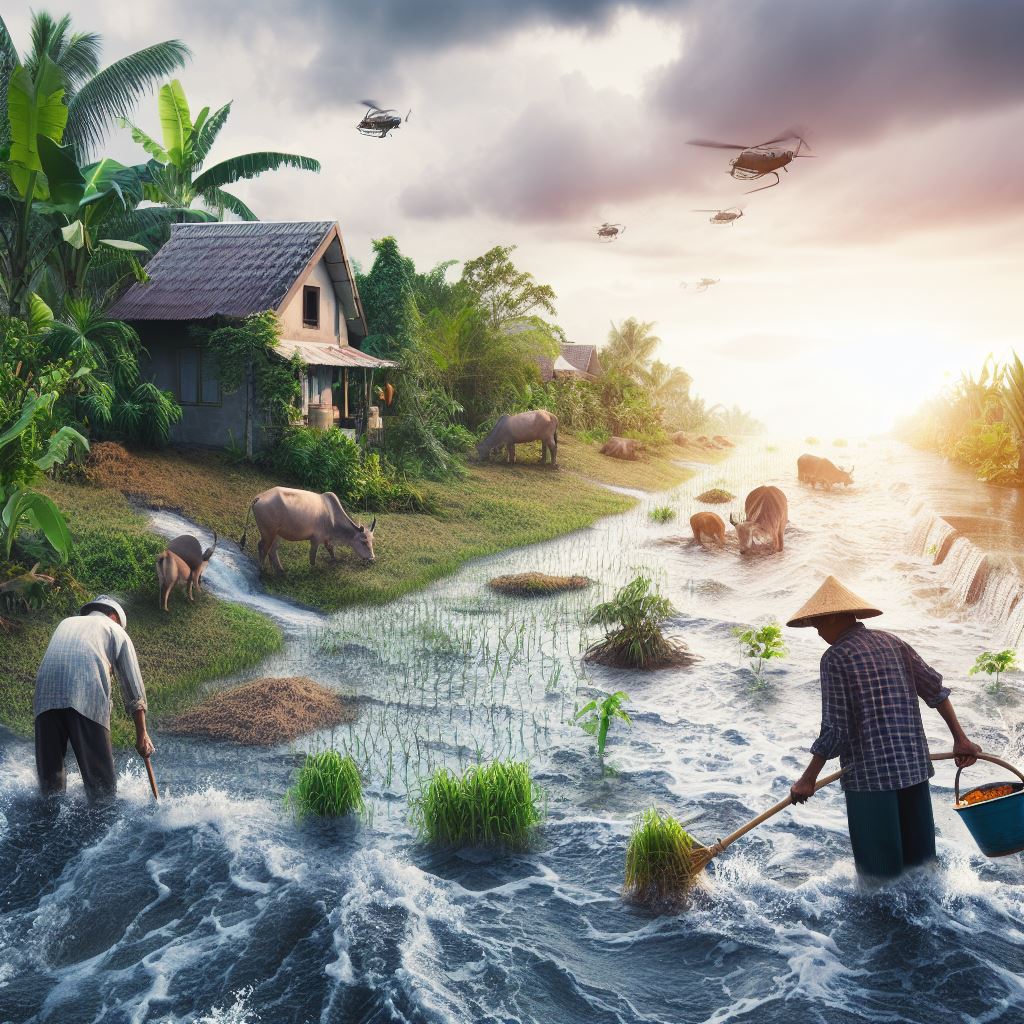Coastal Farms: Rising Sea Levels’ Big Impact
Last Updated on November 22, 2023
Introduction
Coastal farms play a crucial role in sustaining food production, supporting local economies, and preserving biodiversity.
These farms are unique as they are located in close proximity to the ocean, making them vulnerable to rising sea levels.
Rising sea levels, a result of climate change, present a major threat to coastal farms.
As sea levels rise, the protective barrier of coastal landscapes diminishes, making these farms more susceptible to flooding, erosion, and the intrusion of saltwater.
The consequences of rising sea levels on coastal farms are manifold.
The increased frequency and severity of floods can damage crops, destroy infrastructure, and contaminate freshwater sources.
Erosion caused by wave action can lead to the loss of productive land, making agriculture unsustainable.
Furthermore, saltwater intrusion poses a significant challenge for coastal farmers.
As seawater infiltrates the soil and groundwater tables, the salinity levels increase, which negatively affect the growth and yield of crops.
This intrusion can also harm sensitive ecosystems and disrupt the intricate balance of coastal habitats.
The purpose of this blog post is to raise awareness about the consequences of rising sea levels on coastal farms.
By understanding the magnitude of this issue, we can develop strategies to mitigate its impact and promote sustainable agricultural practices.
In the following sections, we will explore the specific challenges faced by coastal farmers, discuss potential solutions, and emphasize the importance of collaboration between stakeholders to address this pressing issue.
Together, we can safeguard our coastal farms and ensure food security for future generations.
Understanding Rising Sea Levels
Explanation of the causes
- The primary cause of rising sea levels is the melting of glaciers and ice caps.
- Global warming is accelerating this process, causing the polar ice sheets to thaw.
- Another contributor is the expansion of seawater due to its temperature increase.
Impact of climate change on sea levels
- As temperatures rise, extreme weather events like hurricanes and storms intensify.
- These events result in increased erosion of coastal areas, contributing to rising sea levels.
- Climate change also affects ocean currents, which can lead to higher sea levels in certain regions.
Statistical data on rising sea levels
- The rate of sea-level rise has more than doubled since the 1900s.
- Over the past century, global sea levels have risen by an average of 8 inches.
- Some areas, like the Western Pacific and the Indian Ocean, have experienced higher increases.
Anticipated future scenarios
- If greenhouse gas emissions continue to rise, sea levels could rise by another 1 to 4 feet by 2100.
- Coastal cities and communities will be at greater risk of flooding and coastal erosion.
- Low-lying islands and coastal regions may become uninhabitable due to constant flooding.
- Displacement of populations will lead to economic and social challenges.
- The loss of coastal farms and saltwater intrusion will impact food production and livelihoods.
Understanding the causes, impacts, statistical data, and future scenarios of rising sea levels is crucial.
As the effects of climate change become more evident, urgent actions are needed to mitigate these risks.
Efforts to reduce carbon emissions, strengthen coastal defenses, and adapt to rising sea levels must be prioritized.
We need to protect coastal farms and the communities that rely on them for food security and economic stability.
By addressing rising sea levels, we can mitigate the major impact climate change has on our shores.
Together, let’s work towards a sustainable future where our coastal farms can thrive despite the challenges they face.
Read: Climate’s Toll on Soil: Farming’s Unsung Hero
Vulnerability of Coastal Farms
Location near water bodies
Coastal farms are inherently vulnerable due to their proximity to water bodies such as oceans, seas, or rivers.
This location exposes them to the impacts of rising sea levels.
Risk of saline intrusion
One of the major challenges faced by coastal farms is the risk of saline intrusion.
As sea levels rise, saltwater can infiltrate and contaminate freshwater sources essential for irrigation and farming.
Flooding and soil erosion
Coastal farms are susceptible to increased flooding and soil erosion caused by rising sea levels.
As water levels rise, it becomes easier for farmland to be inundated, destroying crops and causing erosion that degrades the quality of the soil.
Damage to infrastructure
Rising sea levels pose a threat to the infrastructure of coastal farms.
Farm buildings, irrigation systems, and machinery are at risk of damage or destruction from flooding, storm surges, and coastal erosion.
These vulnerabilities necessitate careful planning and adaptation strategies to ensure the long-term sustainability of coastal farming communities.
Adaptation Measures for Coastal Farms
Coastal zone management
Implementing effective coastal zone management strategies can help mitigate some of the vulnerabilities faced by coastal farms.
This includes regulating and controlling land use near the coast to minimize potential risks and conflicts.
Diversification of crops
Coastal farms can adapt to rising sea levels by diversifying their crop selection.
By experimenting with new crops that are more tolerant of saline conditions, farmers can safeguard their livelihoods and maintain food production.
Improved irrigation techniques
Developing and implementing improved irrigation techniques is essential for coastal farms.
Innovations such as drip irrigation or alternative water sources can reduce the reliance on freshwater and minimize the impact of saline intrusion on crop growth.
Coastal landscaping and erosion control
Coastal farms can benefit from coastal landscaping and erosion control measures.
Planting vegetation, such as mangroves or dune grasses, can help stabilize the coastline, prevent erosion, and protect farmland from the damaging effects of rising sea levels.
Infrastructure adaptation
Adapting the infrastructure of coastal farms is vital to withstand the impacts of rising sea levels.
This includes elevating buildings and machinery, constructing flood-resistant structures, and implementing proper drainage systems to mitigate flooding risks.
Collaboration and knowledge sharing
Coastal farming communities must foster collaboration and knowledge sharing.
By connecting with researchers, government agencies, and other farmers, communities can exchange information, learn from successful adaptation efforts, and collectively address the challenges posed by rising sea levels.
Coastal farms are particularly vulnerable to the impacts of rising sea levels.
Their location near water bodies, risk of saline intrusion, flooding, soil erosion, and potential damage to infrastructure make them susceptible to significant challenges.
However, through proactive planning and adaptation strategies, coastal farms can mitigate some of these vulnerabilities.
By implementing appropriate coastal zone management, diversifying crops, improving irrigation techniques, practicing coastal landscaping and erosion control, adapting infrastructure, and fostering collaboration, coastal farming communities can ensure their long-term sustainability despite rising sea levels.
It is imperative to prioritize the resilience and adaptability of coastal farms to secure food production, conserve farmland, and protect the livelihoods of farmers who rely on these vulnerable coastal areas.
Read: Greenhouse Gases: Farming’s Role and Solutions

Impact on Farming Practices
Agriculture is one of the most affected sectors by the rising sea levels and coastal farms are facing significant challenges.
As the sea encroaches on these farms, it brings saltwater intrusion and increased flooding, disrupting traditional farming practices.
In order to cope with these changes, farmers have been forced to make adjustments in their crop selection, farming techniques, reliance on technology, and adoption of new strategies for crop diversity and adaptation.
Changes in Crop Selection
Coastal farms have had to reconsider their crop selection due to the changing conditions caused by rising sea levels.
Many traditional crops are not resilient enough to withstand saltwater intrusion and increased flooding.
As a result, farmers are shifting their focus towards salt-tolerant crops that can thrive in such conditions.
This change in crop selection ensures a more sustainable and profitable farming system in the face of environmental challenges.
Introduction of New Farming Techniques
To adapt to rising sea levels, coastal farmers have implemented new farming techniques that minimize the negative impacts caused by saltwater intrusion.
One such technique is the use of raised beds or elevated platforms to keep crops above the water level.
This method helps prevent waterlogged roots and reduces the risk of crop loss.
Additionally, drip irrigation systems have been introduced to limit the use of water and increase the efficiency of nutrient delivery to the plants.
Increased Reliance on Technology
With the challenges posed by rising sea levels, coastal farmers have turned to technology to optimize their farming practices.
Advanced weather forecasting systems enable farmers to prepare for extreme weather events and make informed decisions regarding planting and harvesting.
Additionally, the use of precision agriculture technologies, such as drones and sensors, allows farmers to monitor crop health and optimize resource allocation, resulting in increased productivity and reduced environmental impact.
Crop Diversity and Adaptation Strategies
In order to minimize the risks associated with rising sea levels, coastal farmers are adopting crop diversity and implementing adaptation strategies.
Crop diversity spreads the risk of crop failure, as different crops have varying tolerance levels to saltwater intrusion and flooding.
Farmers are also implementing soil management techniques, such as improving drainage systems and applying organic matter, to enhance soil fertility and water retention capacity.
These strategies contribute to the resilience of coastal farms, enabling them to withstand the challenges posed by rising sea levels.
In short, rising sea levels have a significant impact on coastal farms and their farming practices.
However, by making necessary adjustments in crop selection, adopting new farming techniques, relying on technology, and implementing crop diversity and adaptation strategies, farmers can mitigate the negative effects and secure the sustainability of coastal farming.
It is crucial for farmers, policymakers, and researchers to collaborate and find innovative solutions to ensure the resilience and survival of coastal farms in the face of climate change.
Read: Innovative Crops: Beating Climate Heat & Drought
Economic Consequences
Loss of productive land
- Rising sea levels pose a major threat to coastal farms, leading to the loss of productive land.
- As the sea creeps inland, fertile farmland is gradually engulfed, rendering it unsuitable for cultivation.
- The loss of productive land decreases the overall agricultural output and disrupts the food supply chain.
- Coastal farmers, who heavily rely on this land for their livelihood, face significant economic hardships.
Decline in agriculture-based economy
- Coastal regions often have economies that are deeply intertwined with agriculture and its related industries.
- With the loss of productive land, the agriculture-based economy of these regions experiences a significant decline.
- Local businesses that rely on the agricultural sector, such as equipment suppliers and packaging companies, also suffer.
- The decline in the agriculture-based economy leads to job losses and a decrease in income for local communities.
Effects on local communities
- Coastal communities in close proximity to farms heavily rely on agriculture for their sustenance.
- The decline of the agriculture-based economy directly impacts the livelihoods of these communities.
- Loss of jobs in farming and related industries forces residents to seek alternative employment opportunities elsewhere.
- Dispersal of community members and their migration can lead to the breakdown of social networks and support systems.
Potential for food insecurity
- Coastal farms play a crucial role in ensuring food security for nearby communities and beyond.
- The loss of productive land can disrupt local food production, leading to a potential increase in food insecurity.
- Inadequate agricultural output may result in higher food prices, making it difficult for vulnerable populations to afford nutritious meals.
- Dependence on imported food increases, making communities more vulnerable to fluctuations in global food markets.
The economic consequences of rising sea levels on coastal farms are manifold.
The loss of productive land reduces agricultural output, leading to a decline in the agriculture-based economy.
Local communities suffer from job losses and a potential increase in food insecurity.
It is crucial to develop strategies to mitigate these impacts and support affected coastal farms and communities.
Read: Future of Farming: Tech against Climate Change
Environmental Implications
Loss of biodiversity
- Rising sea levels pose a significant threat to coastal farms and the rich biodiversity they harbor.
- As the water encroaches, it engulfs coastal habitats, leading to the loss of flora and fauna species.
- The destruction of these ecosystems disrupts the delicate balance of nature and reduces overall biodiversity.
- This loss not only affects wildlife but also has a cascading effect on the entire food chain.
- Many species that rely on these habitats for breeding, feeding, and shelter are put at risk of extinction.
Impact on marine ecosystems
- Rising sea levels directly affect the health and stability of marine ecosystems.
- Coastal farms are often located near estuaries, which are critical breeding grounds for many marine species.
- The inundation of these areas disrupts the delicate balance and lifecycle of these species.
- Increased salinity levels due to rising tides can also harm marine organisms, affecting their growth and reproduction.
- The loss of these ecosystems not only threatens marine life but also diminishes the overall resilience of the oceans.
Displacement of wildlife habitats
- Coastal farms act as important buffers, providing habitats for a variety of wildlife species.
- Rising sea levels result in the loss of these habitats, forcing wildlife to seek new areas for survival.
- The displacement of these species can have detrimental effects on their ability to find suitable environments.
- The competition for resources among displaced wildlife can lead to an imbalance in the natural ecosystem.
- The disruption of habitats can also increase the risk of human-wildlife conflicts as animals search for new territories.
Threat to coastal ecosystem services
- Coastal farms provide valuable ecosystem services that benefit both humans and the environment.
- Rising sea levels jeopardize these services, such as flood protection and water filtration.
- Loss of coastal habitats diminishes their ability to absorb storm surges and reduce the impact of hurricanes.
- Wetlands and mangroves, commonly found in coastal farms, act as natural filters, purifying water before it enters the sea.
- With the destruction of these ecosystems, the quality of water and its ability to support marine life decline.
Baically, the environmental implications of rising sea levels on coastal farms are profound and far-reaching.
The loss of biodiversity, disruption of marine ecosystems, displacement of wildlife habitats, and threat to ecosystem services are just a few of the challenges we face.
It is crucial that we take proactive measures to mitigate the impacts and adapt to this changing reality.
By implementing sustainable farming practices, protecting and restoring coastal habitats, and fostering collaboration between stakeholders, we can help safeguard our coastal farms and the invaluable ecosystems they support.
Adaptation and Mitigation Measures
Government policies and regulations
- Implementing strict regulations and policies to safeguard coastal farms from the impacts of rising sea levels.
- Enforcing zoning restrictions to limit agricultural activities in vulnerable coastal areas.
- Providing financial incentives to farmers for adopting climate-smart practices and investing in resilient infrastructure.
- Collaborating with scientific communities to develop adaptive strategies and long-term plans for coastal farming.
Building resilient infrastructure
- Constructing sea walls, levees, or breakwaters to protect coastlines and mitigate the effects of rising sea levels.
- Investing in modern irrigation systems and drainage networks that minimize water loss and enhance soil quality.
- Designing farm structures and buildings with materials resistant to saltwater corrosion and flooding.
- Incorporating aquaculture and hydroponics systems to diversify farming methods and reduce reliance on traditional practices.
Promoting sustainable farming practices
- Encouraging farmers to adopt climate-smart agricultural techniques such as agroforestry and conservation tillage.
- Implementing precision agriculture technologies to optimize resource use and reduce greenhouse gas emissions.
- Promoting organic farming practices to improve soil health and reduce the need for chemical inputs.
- Facilitating the integration of renewable energy sources into farm operations, such as solar panels or wind turbines.
Collaborative efforts and awareness campaigns
- Fostering partnerships between farmers, government organizations, and community stakeholders to share knowledge and resources.
- Conducting educational programs and workshops to raise awareness about the impacts of rising sea levels on coastal farms.
- Organizing community dialogues and forums to engage the public in discussions on sustainable farming and climate change adaptation.
- Supporting research initiatives to monitor and assess the effectiveness of adaptation and mitigation measures.
As rising sea levels pose significant challenges to coastal farms, it is crucial to implement adaptation and mitigation measures to sustain agricultural practices in these vulnerable areas.
Government policies and regulations, resilient infrastructure, sustainable farming practices, and collaborative efforts are key components of a comprehensive strategy towards ensuring the resilience and long-term viability of coastal farming.
By working together, we can protect agricultural livelihoods, preserve valuable lands, and contribute to a sustainable future amidst the changing climate.
Case Studies and Success Stories
Examples of coastal farms adapting to rising sea levels:
- In Florida, farmers have elevated their fields and installed drainage systems to counter flooding.
- Some farmers in Bangladesh have embraced floating gardens, utilizing water hyacinths and other aquatic plants.
- In the Netherlands, coastal farms have implemented dikes, pumps, and innovative water management techniques.
Innovative solutions and technological advancements
- Researchers have developed salt-tolerant crop varieties that can thrive in saline conditions.
- Farmers are using precision agriculture techniques, such as remote sensing and drones, to monitor crops.
- Improved irrigation systems, like drip irrigation, are helping reduce water usage in coastal farming.
Importance of sharing knowledge and experiences
- Coastal farmers should share their successful adaptation strategies with vulnerable communities.
- Collaboration between farmers, scientists, and policymakers can lead to more effective solutions.
- Knowledge sharing platforms and workshops can facilitate the exchange of ideas and best practices.
Coastal farms worldwide are under increasing threat from rising sea levels caused by climate change.
These farms, which rely on proximity to the coast for irrigation and access to markets, face numerous challenges due to changing environmental conditions.
However, there are inspiring examples of coastal farms adapting to these circumstances, as well as innovative solutions and technological advancements that can help mitigate the impact of rising sea levels.
Examples of coastal farms adapting to rising sea levels
In areas like Florida, where rising sea levels have caused more frequent flooding, farmers have been forced to find creative solutions.
Some have elevated their fields using fill dirt, effectively raising them above water levels.
Additionally, they have implemented drainage systems to remove excess water and prevent waterlogging.
These adaptations have allowed farmers to continue their operations and protect their crops against inundation.
Similarly, farmers in low-lying regions such as Bangladesh have faced unique challenges from rising sea levels.
However, they have embraced innovative techniques like floating gardens.
These floating gardens consist of platforms made from water hyacinths and other aquatic plants, providing a sustainable and resilient farming method.
By growing vegetables and other crops on these platforms, farmers can adapt to waterlogged conditions and maintain their livelihoods.
In the Netherlands, where much of the land lies below sea level, coastal farms have implemented comprehensive systems to combat rising sea levels.
They have constructed dikes and pumping stations to keep water out of the farmland.
Additionally, they have embraced innovative water management techniques, such as water retention areas and precision irrigation systems.
These advancements have not only protected farmland but also reduced the reliance on freshwater resources.
Innovative solutions and technological advancements
Researchers and farmers are working together to develop innovative solutions that can help coastal farms adapt to rising sea levels.
One approach is the development of salt-tolerant crop varieties.
These crops can withstand high salinity levels in the soil and irrigation water, ensuring better yields even in coastal areas affected by saltwater intrusion.
The use of remote sensing and drones allows farmers to monitor crop conditions and make informed decisions regarding irrigation and pest control.
Additionally, improved irrigation systems like drip irrigation minimize water wastage and increase the efficiency of water use, particularly in regions where fresh water is scarce.
Importance of sharing knowledge and experiences
As coastal farms face similar challenges worldwide, it is crucial to share knowledge and experiences to develop effective adaptation strategies.
Successful examples of coastal farm adaptations should be shared with vulnerable communities facing similar threats.
Collaboration between farmers, scientists, and policymakers can lead to the development of policies and practices that prioritize the resilience of coastal farms.
Knowledge sharing platforms, workshops, and conferences can facilitate the exchange of ideas and best practices, allowing farmers to learn from one another and collectively address the challenges posed by rising sea levels.
Rising sea levels present significant challenges for coastal farms.
However, through innovative adaptation strategies, technological advancements, and knowledge sharing, farmers can overcome these challenges and ensure the sustainability of coastal agricultural systems.
By learning from successful case studies and collaborating across sectors, we can build a resilient future for coastal farming in the face of climate change.
Conclusion
Rising sea levels have had a significant impact on coastal farms.
To combat this, we must take action and adopt sustainable and resilient farming practices.
Addressing climate change is crucial for the future of agriculture and food security.
Coastal farms face an imminent threat from rising sea levels.
Agricultural landscapes are transforming rapidly.
Innovative adaptation strategies are crucial.
Farmers must embrace resilient practices.
Government intervention is imperative.
Sustainable aquaculture presents a viable alternative.
Collaboration among stakeholders is pivotal.
Urgent action is non-negotiable.
The resilience of coastal communities hangs in the balance.
Adaptation is the key to agricultural sustainability.
The impact of sea level rise demands immediate attention.
Our coastal farms’ fate is intertwined with global efforts to combat climate change.
The time to act is now.
Let us forge a path towards a more sustainable and resilient future for coastal agriculture.


